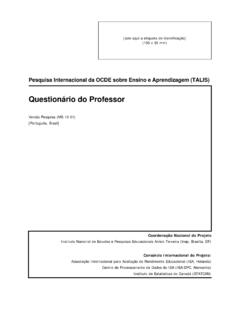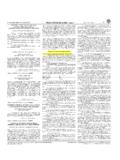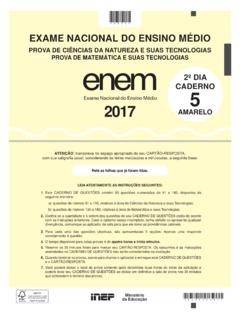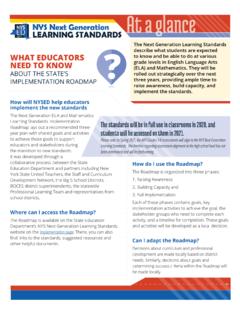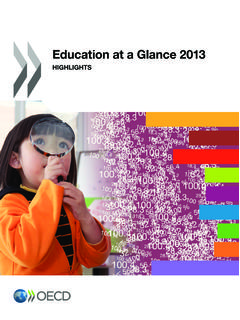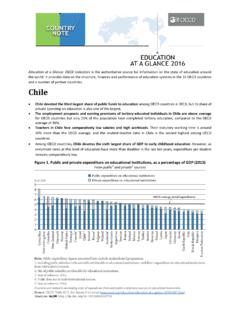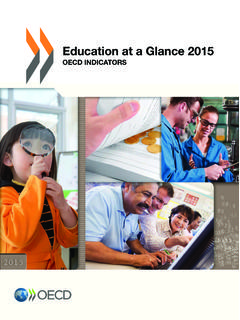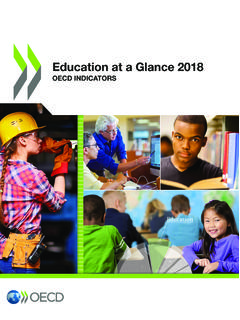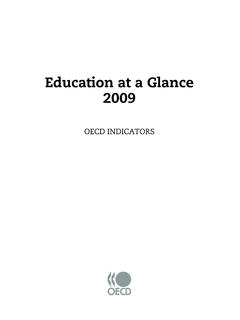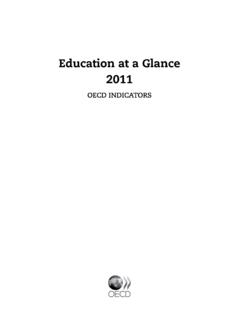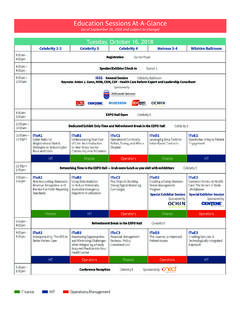Transcription of Education at a Glance 2017 - INEP
1 EducationEducationUnder embargo until 12 September 2017 at CESTE ducation at a Glance 2017 OECD INDICATORSE ducation at a Glance2017 OECD INDICATORSThe statistical data for Israel are supplied by and under the responsibility of the relevant Israeli authorities. The use of such data by the OECD is without prejudice to the status of the Golan Heights, East Jerusalem and Israeli settlements in the West Bank under the terms of international law. Photo credits: Christopher Futcher / iStock Marc Romanelli / Gettyimages michaeljung / Shutterstock Pressmaster / Shutterstock Corrigenda to OECD publications may be found on line at: OECD 2017 You can copy, download or print OECD content for your own use, and you can include excerpts from OECD publications, databases and multimedia products in your own documents, presentations, blogs, websites and teaching materials, provided that suitable acknowledgment of the source and copyright owner is given.
2 All requests for public or commercial use and translation rights should be submitted to Requests for permission to photocopy portions of this material for public or commercial use shall be addressed directly to the Copyright Clearance Center (CCC) at or the Centre fran ais d exploitation du droit de copie (CFC) at work is published under the responsibility of the Secretary-General of the OECD. The opinions expressed and arguments employed herein do not necessarily reflect the official views of the OECD member document, as well as any data and any map included herein, are without prejudice to the status of or sovereignty over any territory, to the delimitation of international frontiers and boundaries and to the name of any territory, city or cite this publication as: OECD ( 2017 ), Education at a Glance 2017 : OECD Indicators, OECD Publishing, Paris.
3 (print) 978-92-64-27976-6 ISBN (PDF) 978-92-64-27983-4 Education at a Glance 2017 : OECD Indicators OECD 20173 Governments are increasingly looking to international comparisons of Education opportunities and outcomes as they develop policies to enhance individuals social and economic prospects, provide incentives for greater efficiency in schooling, and help to mobilise resources to meet rising demands. The OECD Directorate for Education and Skills contributes to these efforts by developing and analysing the quantitative, internationally comparable indicators that it publishes annually in Education at a Glance . Together with OECD country policy reviews, these indicators can be used to assist governments in building more effective and equitable Education at a Glance addresses the needs of a range of users, from governments seeking to learn policy lessons to academics requiring data for further analysis to the general public wanting to monitor how its country s schools are progressing in producing world-class students.
4 The publication examines the quality of learning outcomes, the policy levers and contextual factors that shape these outcomes, and the broader private and social returns that accrue to investments in at a Glance is the product of a long-standing, collaborative effort between OECD governments, the experts and institutions working within the framework of the OECD Indicators of Education Systems (INES) programme and the OECD Secretariat. The publication was prepared by the staff of the Innovation and Measuring Progress Division of the OECD Directorate for Education and Skills, under the responsibility of Dirk Van Damme and Marie-H l ne Doumet and in co-operation with tienne Albiser, Manon Costinot, Corinne Heckmann, Michael Jacobs, Karinne Logez, Camila de Moraes, Simon Normandeau, Joris Ranchin, Gara Rojas Gonz lez, Martha Rozsi, Daniel S nchez Serra, Markus Schwabe and Giovanni Maria Semeraro.
5 Administrative support was provided by Laetitia Dehelle, and additional advice and analytical support were provided by Anithasree Athiyaman, Fatine Guedira, Michaela Horvathova, Sandrine Kergroach, Axelle Magnier, Gabriele Marconi, Nicolas Miranda, Junyeong Park and Roland Tusz. Marilyn Achiron, Cassandra Davis and Sophie Limoges provided valuable support in the editorial and production process. The development of the publication was steered by member countries through the INES Working Party and facilitated by the INES Networks. The members of the various bodies as well as the individual experts who have contributed to this publication and to OECD INES more generally are listed at the end of the much progress has been accomplished in recent years, member countries and the OECD continue to strive to strengthen the link between policy needs and the best available internationally comparable data.
6 This presents various challenges and trade-offs. First, the indicators need to respond to Education issues that are high on national policy agendas, and where the international comparative perspective can offer added value to what can be accomplished through national analysis and evaluation. Second, while the indicators should be as comparable as possible, they also need to be as country-specific as is necessary to allow for historical, systemic and cultural differences between countries. Third, the indicators need to be presented in as straightforward a manner as possible, while remaining sufficiently complex to reflect multi-faceted realities. Fourth, there is a general desire to keep the indicator set as small as possible, but it needs to be large enough to be useful to policy makers across countries that face different challenges in OECD will continue not only to address these challenges vigorously and develop indicators in areas where it is feasible and promising to develop data, but also to advance in areas where a considerable investment still needs to be made in conceptual work.
7 The OECD Programme for International Student Assessment (PISA) and its extension through the OECD Programme for the International Assessment of Adult Competencies (Survey of Adult Skills [PIAAC]), as well as the OECD Teaching and Learning International Survey (TALIS), are major efforts to this Education at a Glance 2017 : OECD Indicators OECD 20175 Name of the indicator in the 2016 editionT C A1A2A3A4A5 Editorial: Building for the : The indicators and their framework ..13 Reader s guide ..17 Executive summary ..23 The Education sustainable development goal ..27 CHAPTER A THE OUTPUT OF EDUCATIONAL INSTITUTIONS AND THE IMPACT OF A1 To what level have adults studied? ..42 Table Educational attainment of 25-64 year-olds (2016) ..50 Table Trends in educational attainment of 25-34 year-olds (2000, 2005, 2010, 2015 and 2016).
8 51 Table Field of study among tertiary-educated 25-64 year-olds (2016) ..52 Indicator A2 Who is expected to graduate from upper secondary Education ? ..54 Table Profile of upper secondary graduates from general and vocational programmes (2015) ..61 Table Upper secondary and post-secondary non-tertiary graduation rates (2015) ..62 Table Trends in upper secondary and post-secondary non-tertiary first-time graduation rates (2005, 2010 and 2015) ..63 Indicator A3 Who is expected to graduate from tertiary Education ? ..64 Table Distribution of tertiary graduates, by field of study (2015) ..72 Table Profile of a first-time tertiary graduate (2015) ..73 Table First-time graduation rates, by tertiary level (2015) ..74 Indicator A4 To what extent does parents Education influence their children s educational attainment?
9 76 Table Tertiary attainment among adults whose parents both have less than tertiary educational attainment, by type of programme and age group (2012 or 2015)..85 Table Tertiary attainment among adults who have at least one parent who attained tertiary Education , by type of programme and age group (2012 or 2015) ..86 Table Changes in the likelihood of having a tertiary-type A or an advanced research programme degree, by gender, age group and parents educational attainment (2012 or 2015) ..87 Indicator A5 How does educational attainment affect participation in the labour market? ..88 Table Employment rates of 25-64 year-olds, by educational attainment (2016)..100 Table Trends in employment rates of 25-34 year-olds, by educational attainment (2000, 2005, 2010, 2015 and 2016) ..101 Table Employment rates of tertiary-educated 25-64 year-olds, by field of study (2016).
10 102 Table Employment, unemployment and inactivity rates of 25-34 year-olds, by educational attainment (2016) ..103T C Education at a Glance 2017 : OECD Indicators OECD 20176 Name of the indicator in the 2016 editionA6A7A8B1B2 Indicator A6 What are the earnings advantages from Education ? ..104 Table Relative earnings of workers, by educational attainment (2015) ..114 Table Level of earnings relative to median earnings, by educational attainment (2015) ..115 Table Differences in earnings between female and male workers, by educational attainment and age group (2015)..116 Indicator A7 What are the financial incentives to invest in Education ? ..118 Table Private costs and benefits for a man attaining tertiary Education (2013) ..129 Table Private costs and benefits for a woman attaining tertiary Education (2013).





